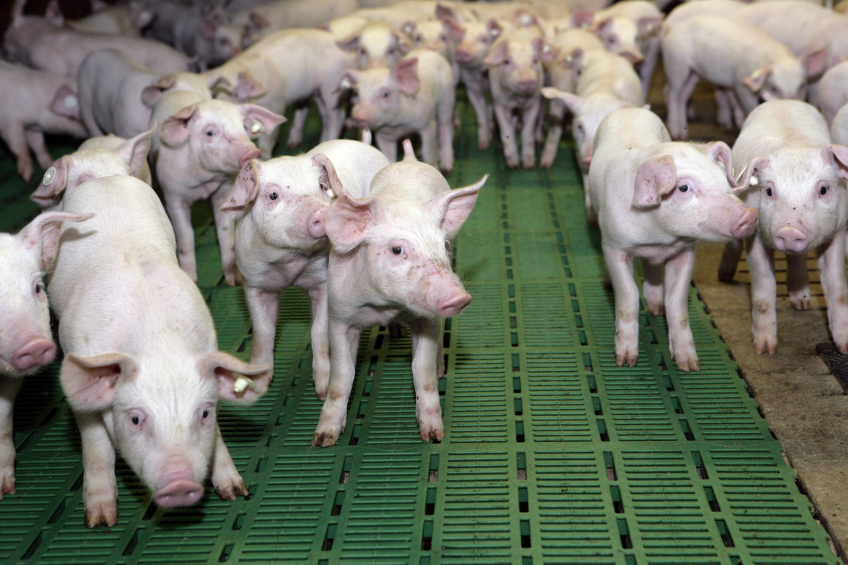Combat gut bacteria in pigs naturally

A recent trial on the use of natural ingredients in grower pig feed, showed that E. coli was controlled well, beneficial gut bacteria continued to thrive and pig growth was promoted. Let’s look at alternative ways to control pathogens in pig production.
Today’s livestock production faces the challenge of having to achieve high productivity and delivering high quality products at the same time. Optimum growth performance in livestock production is continuously endangered by bacteria which cause energy losses and negatively impact growth. To combat bacteria and support performance, antibiotic growth promoters (AGPs) and/or natural growth promoters (NGPs) can be used.
Table 1 – Antibiotic vs. natural growth promoters.
The use of antibiotics as growth promoters in healthy animals was practised for decades and it is still common practice in many countries. But in a number of countries the use of antibiotics for growth promoting issues has been banned and/or regulated. This led to the development of alternative products, which can be used instead of antibiotic growth promoters. Because natural growth promoters possess strong antimicrobial activity, they offer hygiene and digestibility benefits – similar to antibiotics. Whereas antibiotics kill both harmful and beneficial bacteria, NGPs have been shown to suppress often harmful Gram-negative bacteria and promote beneficial bacteria (Table 1).
Organic acids as alternatives to AGP have increasingly and successfully been supplemented in piglet nutrition. Acids reduce the microbial load, aid the buffering capacity and reduce the pH in the feed and in the gastrointestinal tract, which increases nutrient uptake. Besides organic acids, phytochemicals have also proven antimicrobial activity. For example cinnamaldehyde (CA) as a phytochemical is able to target so-called ‘FtsZ proteins’, that have an essential role in the cell division, inhibiting the formation of the Z-ring and cell division. Despite the fact that natural replacements for AGPs are known, fighting Gram-negative bacteria is still a challenge. The outer membrane of Gram-negative bacteria acts as a barrier that prevents antimicrobial compounds from entering the cell and destroying vital functions. This outer membrane can be destabilised by a permeabilising substance (PS), which makes the bacterial cell more susceptible to antimicrobial compounds.
Trial in China – weaning pigs
Recent trial results indicate that a combination of organic acids, cinnamaldehyde and a permeabilising complex (ACPC) in a form of a commercial product, Biotronic Top3, can balance digestive microbiota and improve growth of piglets better than an antibiotic growth promoter.
A 56-day trial was carried out at the Research Center of Hunan Agricultural University, Changsha, Hunan, China, using 96 weaning pigs. Pigs (body weight 10.5 kg; 35 days) were assigned to three treatments. The negative control group diet contained no feed additives, whereas the positive control group was supplemented with antibiotics (100 g/t colistin and 100 g/t chlortetracycline) and the diet of the trial group supplemented with ACPC at the inclusion rate of 1.0 kg/t feed. The weight and feed intake of the pigs was recorded at each diet change. After 56 days pigs were euthanised and the pH of digesta in stomach and jejunum was measured. The content of the ileum was collected and analysed for E. coli, Salmonella, Lactobacilli and Bifidobacteria populations.
Performance characteristics – feed conversion, average daily gain
Growth performance was improved due to the supplementation of the diets with ACPC (Table 2). Body weight (BW) at trial day 56 was similar in positive and negative control groups, but 13% higher in the trial group when compared to the negative control group and 11% higher when compared to the positive control group. Average daily gain (ADG) was improved in the ACPC group compared to the negative and positive control groups. Also average daily feed intake (ADFI) increased in the ACPC group compared to the negative and positive control groups. Feed conversion ratio (FCR) was similar in all three groups.
The pH levels in the stomach of pigs fed the negative and positive control diet was similar (4.28 vs. 4.30), while pH in the stomachs of pigs fed the ACPC supplemented diet was significantly lower (3.67, P<0.05) compared to other groups. also, ph in the jejunum of the acpc group was lower compared to the ph in the jejunum of the negative and positive control groups. however, differences were not significant (p>0.05).
Microbiota counts in pigs
Microbiological analysis showed that the E. coli counts in the ileum were lowest in the ACPC group (Table 3). E. coli counts found in the ileum of pigs fed the negative control diet were higher compared to E. coli counts found in the ileum of pigs fed the positive control and ACPC diet. Salmonella counts in the ileum of pigs fed the negative control diet were higher compared to Salmonella counts found in the ileum of pigs fed the positive control and the ACPC diet.
In conclusion, the trial showed that feeding ACPC increases growth performance. The addition of ACPC reduced pH of digesta collected from stomach and jejunum. Microbial analysis showed that E. coli and Salmonella in the ileum of pigs were combated as successfully by ACPC as it was by the addition of colistin and chlortetracycline. However, the addition of colistin and chlortetracycline had negative effects on Lactobacilli and Bifidobacteria, while the addition of ACPC increased the amount of beneficial bacteria in the ileum of pigs.
These results indicated that the product containing a combination of organic acids, cinnamaldehyde and a permeabilising complex, improved growth performance in piglets by changing positively the intestinal micro-ecological environment. While no ‘silver bullet’ replacement for antibiotics exists, this suggests that natural growth promoters like ACPC constitute a valuable tool for pathogen control and growth promotion.
Source: Pig Progress magazine, Volume 32.2 (2016)












